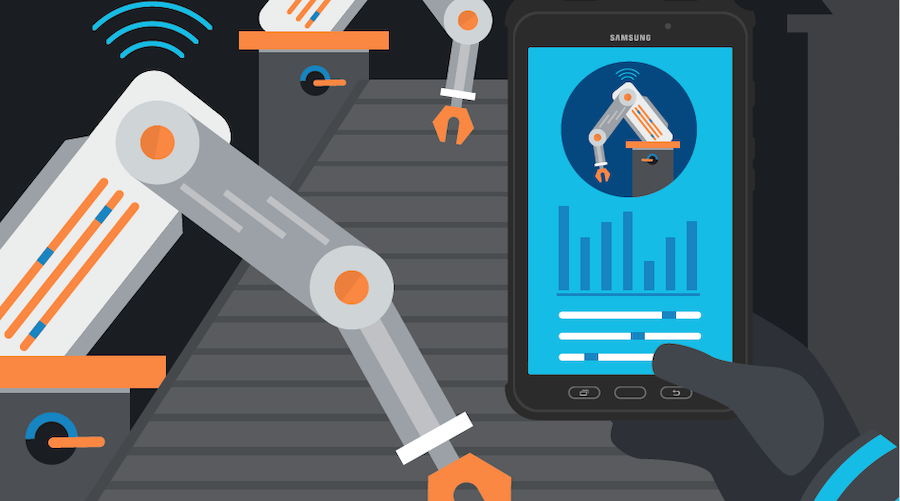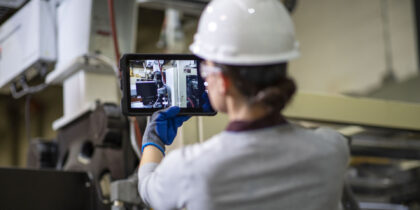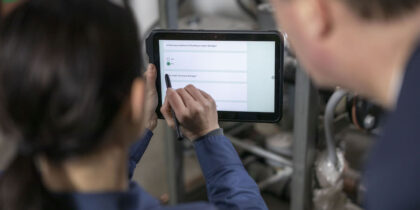Lean manufacturing principles dictate that smart factories rely on a digital core of data. At many manufacturing companies, however, production workers and managers still use paper for work orders, checklists and the like. Those paper-based systems add steps to the data recording process, diminishing operational efficiency. Going paperless is increasingly seen as a crucial step in implementing the move to a smart factory, because purely digital tracking simplifies task management across the board.
When properly implemented, paperless communications utilize digital data gathering and processing in every aspect of the ERP, including human resources, CRM and inventory management solutions. Here are seven process improvements manufacturers can make with paperless solutions.
1. Access Accurate Inventory Data
A paperless system can gather data from scanners in inventory docks and feed this information into the ERP housed on the mobile device. Such an automated solution simplifies the task of reordering crucial materials and supplies at multiple production facilities. If a raw material scan shows that a certain ingredient has reached a low threshold, a purchase order can automatically be activated and sent to the plant manager. A text alert on the manager’s phone can signal that a purchase order needs to be signed, and they can log into the system, sign electronically and submit it to the vendor for processing. Such a seamless end-to-end solution eliminates manual data entry at every step of the process and saves time in having workers chase down managers to get the necessary papers signed.
2. Locate Production Supplies
By using barcode or RFID tags on deliveries of materials, manufacturers can eliminate the use of paper checklists to record incoming shipments. Inventory counts are automatically updated, shipments are recorded with the date and all other details in place, and receiving agents can scan product log files and retrieve relevant geolocation parameters from GPS time stamps. Efficiency and accuracy both improve, while inventory records are easier to retrieve and more up to date. When deliveries are logged electronically and their placement is tracked, production teams can use material logs of RFID tags to locate supplies quickly. Time is saved, and there is no wasted motion retrieving the wrong materials.
Modernize Your Factory With Mobile
Get your free guide to the mobile technologies that will accelerate your smart factory journey. Download Now
3. Decrease Production Downtime
Mobile devices help keep production lines running by improving diagnosis. A repair technician can use augmented reality to layer machine diagrams over photos of failed parts and detect discrepancies. Imagery can be transmitted wirelessly to colleagues and equipment suppliers to assist in diagnosis — all without resorting to pencil and paper. Mobile devices such as the Samsung Galaxy Tab Active2 can also integrate predictive maintenance into the manufacturing plan, which dramatically increases production efficiencies by saving both time and money.
4. Access Outstanding Work Orders Onscreen
When work orders are created and processed online, production teams can get down to work faster by retrieving the orders through their mobile devices. Work orders can be organized by date and grouped in list form with the capability to drill down for details and history. With the Tab Active2, workers can even make use of the screen while wearing gloves.
5. Track Production Workflows Without Paper
Paper-based manufacturing depends on paper work orders, paper instructions for custom requests and paper audits for employee verification. Such a system is error-prone, and plant managers spend too much time checking and double-checking all orders to catch errors. A completely paperless solution, on the other hand, saves time by integrating the bill of materials and work orders into the manufacturer’s ERP. Plant workers access the production tasks in sequence and can clearly see which task is assigned to which worker.
6. Sign Off on Purchase Orders
Once a business has mobilized its task management using virtual desktop infrastructure (VDI) or mobile applications, plant managers can easily sign off on assigned tasks via tablet or phone to keep production processes moving briskly. If a signature is required, managers can use the S Pen on the Tab Active2 to sign swiftly and conveniently.
7. Attend to Human Resource Functions
Workers can clock in and out of a digital device instead of punching in a paper card every time they report for work or take a lunch break. This data is automatically fed into the company’s HR interface without the need for data reentry at the end of the day or week. Employees can also request time off or report sick days using the same paperless solution. This means less time spent filling out paperwork and a lesser chance of the request being misplaced.
Going paperless is a necessary first step on the road to a smart factory. A paperless solution facilitated by mobile devices simplifies task management on various fronts in manufacturing. Of equal importance, it acts as the necessary conduit for the digital core — gathering and processing data and acting on those results to drive large segments of the production process autonomously.
Learn more about using mobile technology to modernize your factory with our free white paper.







